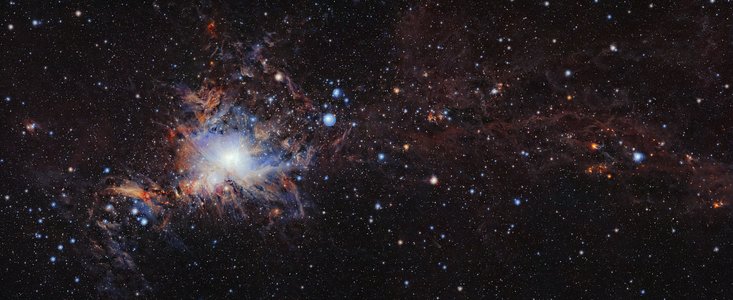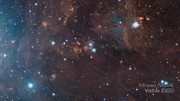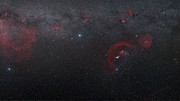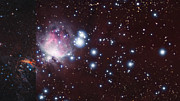Press Release
Hidden Secrets of Orion’s Clouds
VISTA survey gives most detailed view of Orion A molecular cloud in the near-infrared
4 January 2017
This spectacular new image is one of the largest near-infrared high-resolution mosaics of the Orion A molecular cloud, the nearest known massive star factory, lying about 1350 light-years from Earth. It was taken using the VISTA infrared survey telescope at ESO’s Paranal Observatory in northern Chile and reveals many young stars and other objects normally buried deep inside the dusty clouds.
The new image from the VISION survey (VIenna Survey In Orion) is a montage of images taken in the near-infrared part of the spectrum [1] by the VISTA survey telescope at ESO’s Paranal Observatory in Chile. It covers the whole of the Orion A molecular cloud, one of the two giant molecular clouds in the Orion molecular cloud complex (OMC). Orion A extends for approximately eight degrees to the south of the familiar part of Orion known as the sword [2].
VISTA is the world’s largest dedicated survey telescope, and has a large field of view imaged with very sensitive infrared detectors, characteristics that made it ideal for obtaining the deep, high-quality infrared images required by this ambitious survey.
The VISION survey has resulted in a catalogue containing almost 800 000 individually identified stars, young stellar objects and distant galaxies, This represents better depth and coverage than any other survey of this region to date [3].
VISTA can see light that the human eye cannot, allowing astronomers to identify many otherwise hidden objects in the stellar nursery. Very young stars that cannot be seen in visible-light images are revealed when observed at longer infrared wavelengths, where the dust that shrouds them is more transparent.
The new image represents a step towards a complete picture of the star formation processes in Orion A, for both low and high mass stars. The most spectacular object is the glorious Orion Nebula, also called Messier 42 [4] seen towards the left of the image. This region forms part of the sword of the famous bright constellation of Orion (The Hunter). The VISTA catalogue covers both familiar objects and new discoveries. These include five new young stellar object candidates and ten candidate galaxy clusters.
Elsewhere in the image, we can look into Orion A’s dark molecular clouds and spot many hidden treasures, including discs of material that could give birth to new stars (pre-stellar discs), nebulosity associated with newly-born stars (Herbig-Haro objects), smaller star clusters and even galaxy clusters lying far beyond the Milky Way. The VISION survey allows the earliest evolutionary phases of young stars within nearby molecular clouds to be systematically studied.
This impressively detailed image of Orion A establishes a new observational foundation for further studies of star and cluster formation and once again highlights the power of the VISTA telescope to image wide areas of sky quickly and deeply in the near-infrared part of the spectrum [5].
Notes
[1] The VISION survey covers approximately 18.3 square degrees at a scale of about one-third of an arcsecond per pixel.
[2] The other giant molecular cloud in the Orion Molecular Cloud is Orion B, which lies east of Orion’s Belt.
[3] The complete VISION survey includes an even larger region than is shown in this picture, which covers 39 578 x 23 069 pixels.
[4] The Orion nebula was first described in the early seventeenth century although the identity of the discoverer is uncertain. The French comet-hunter Messier made an accurate sketch of its main features in the mid-eighteenth century and gave it the number 42 in his famous catalogue. He also allocated the number 43 to the smaller detached region just north of the main part of the nebula. Later William Herschel speculated that the nebula might be “the chaotic material of future suns” and astronomers have since discovered that the mist is indeed gas glowing in the fierce ultraviolet light from young hot stars that have recently formed there.
[5] The successful VISION survey of Orion will be followed by a new, bigger public survey of other star-forming regions with VISTA, called VISIONS, which will start in April 2017.
More information
This research is presented in a paper entitled “VISION - Vienna survey in Orion I. VISTA Orion A Survey”, by S. Meingast et al., published in the journal Astronomy & Astrophysics.
The team is composed of: Stefan Meingast (University of Vienna, Vienna, Austria), João Alves (University of Vienna, Vienna, Austria), Diego Mardones (Universidad de Chile, Santiago, Chile) , Paula Teixeira (University of Vienna, Vienna, Austria), Marco Lombardi (University of Milan, Milan, Italy), Josefa Großschedl (University of Vienna, Vienna, Austria), Joana Ascenso (CENTRA, Universidade de Lisboa, Lisbon, Portugal; Universidade do Porto, Porto, Portugal), Herve Bouy (Centro de Astrobiología, Madrid, Spain), Jan Forbrich (University of Vienna, Vienna, Austria), Alyssa Goodman (Harvard-Smithsonian Center for Astrophysics, Cambridge MA, USA), Alvaro Hacar (University of Vienna, Vienna, Austria), Birgit Hasenberger (University of Vienna, Vienna, Austria), Jouni Kainulainen (Max-Planck-Institute for Astronomy, Heidelberg, Germany), Karolina Kubiak (University of Vienna, Vienna, Austria), Charles Lada (Harvard-Smithsonian Center for Astrophysics, Cambridge, USA), Elizabeth Lada (University of Florida, Gainesville, USA), André Moitinho (SIM/CENTRA, Universidade de Lisboa, Lisbon, Portugal), Monika Petr-Gotzens (ESO, Garching, Germany), Lara Rodrigues (Universidad de Chile, Santiago, Chile) and Carlos G. Román-Zúñiga (UNAM, Ensenada, Baja California, Mexico).
ESO is the foremost intergovernmental astronomy organisation in Europe and the world’s most productive ground-based astronomical observatory by far. It is supported by 16 countries: Austria, Belgium, Brazil, Czechia, Denmark, France, Finland, Germany, Italy, the Netherlands, Poland, Portugal, Spain, Sweden, Switzerland and the United Kingdom, along with the host state of Chile. ESO carries out an ambitious programme focused on the design, construction and operation of powerful ground-based observing facilities enabling astronomers to make important scientific discoveries. ESO also plays a leading role in promoting and organising cooperation in astronomical research. ESO operates three unique world-class observing sites in Chile: La Silla, Paranal and Chajnantor. At Paranal, ESO operates the Very Large Telescope, the world’s most advanced visible-light astronomical observatory and two survey telescopes. VISTA works in the infrared and is the world’s largest survey telescope and the VLT Survey Telescope is the largest telescope designed to exclusively survey the skies in visible light. ESO is a major partner in ALMA, the largest astronomical project in existence. And on Cerro Armazones, close to Paranal, ESO is building the 39-metre European Extremely Large Telescope, the E-ELT, which will become “the world’s biggest eye on the sky”.
Links
Contacts
Richard Hook
ESO Public Information Officer
Garching bei München, Germany
Tel: +49 89 3200 6655
Email: rhook@eso.org
About the Release
| Release No.: | eso1701 |
| Name: | Orion Molecular Cloud |
| Type: | Milky Way : Nebula : Appearance : Dark : Molecular Cloud |
| Facility: | Visible and Infrared Survey Telescope for Astronomy |
| Instruments: | VIRCAM |
| Science data: | 2016A&A...587A.153M |







